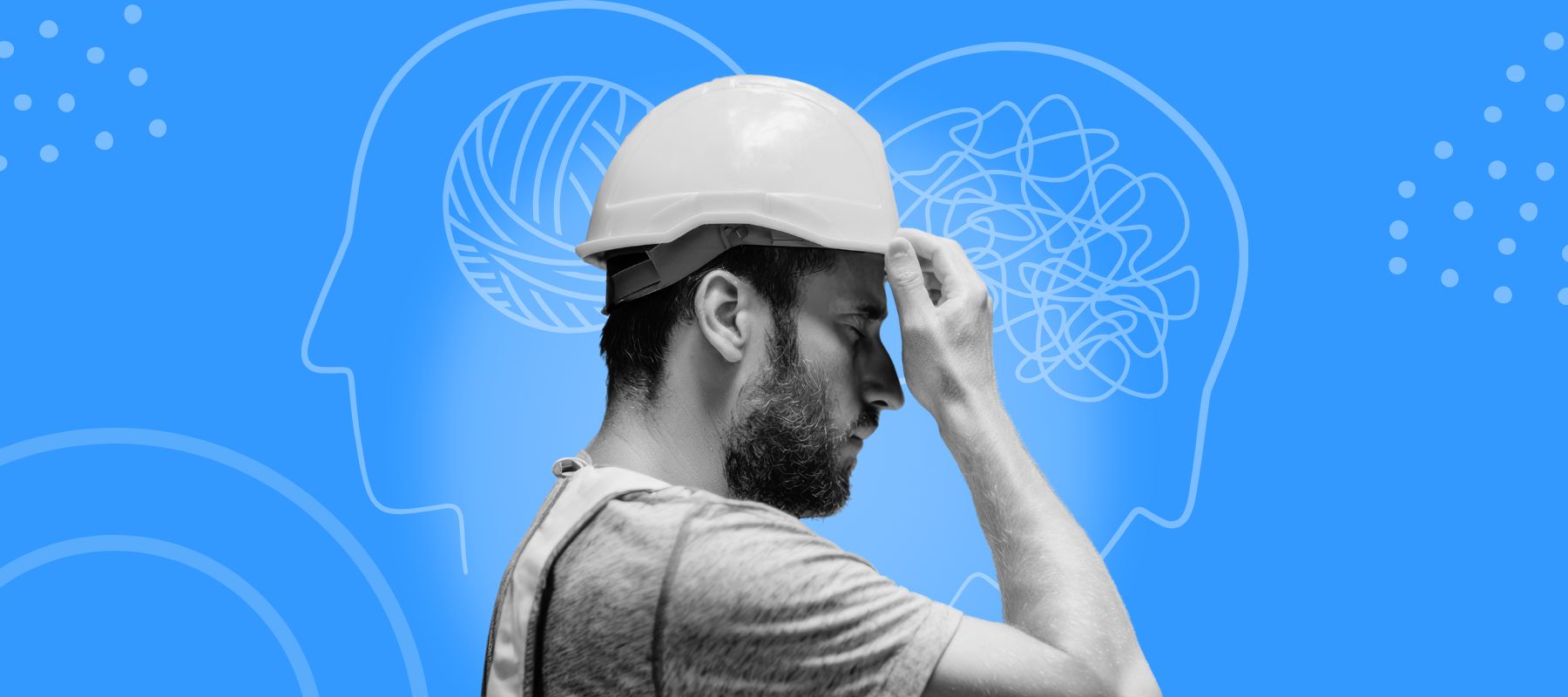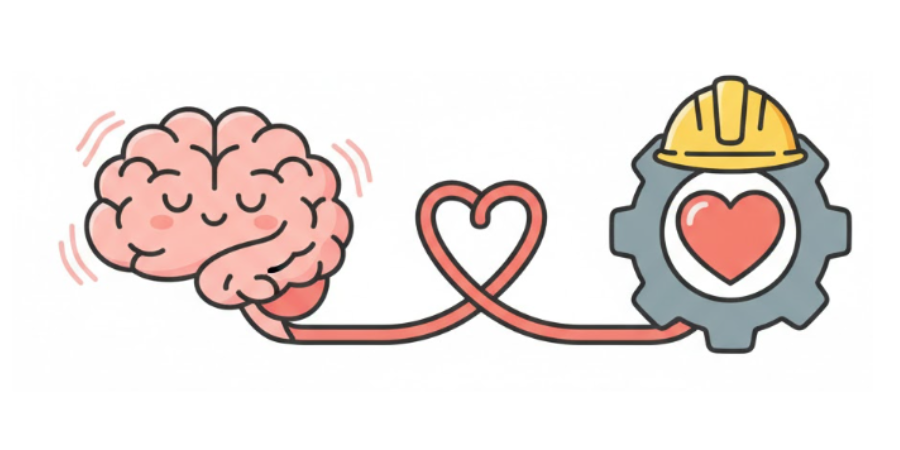AI Summary
Mental health and safety in the workplace are connected through human focus, not just policy.
✨ Stress, anxiety, and fatigue increase the risk of errors, missed hazards, and safety incidents.
✨ Five core pillars: support, control, clarity, relationships, and change — create mentally safe work environments.
✨ Programmes like YOUFactors help teams build habits that reduce risk and make safety a shared mental routine.

Introduction
Mental health and safety in the workplace are closer than we admit.
When someone is stressed, overwhelmed, or running on empty, their world narrows.
They stop noticing the small things. The warning signs. The hazards that sit right in front of them.
Poor mental health slows the mind. It blurs judgement.
It pushes people into rushed decisions that they would never make on a good day.
These moments do not show up on a system.
But they show up in incidents, near-misses, and close calls.
Not because people do not care about safety, but because they are human.
This article looks at how mental health programmes can protect that human side.
It shows how better support leads to better awareness, better decisions, and fewer errors.
The Link Between Mental Health and Workplace Safety

Mental health and safety in the workplace are linked and that means that people’s mental state affects their actions.
Every task relies on clear thinking, sharp focus, and sound judgement. When any of these break down, risk increases.
Stress, fatigue, and anxiety do more than lower morale. They reduce focus.
They slow reaction time.
They make it easier to miss small problems before they become big ones.
A worker under pressure might rush through a lockout step.
A tired driver might overlook a blind spot.
An anxious team leader might avoid raising a concern.
These are not system failures.
They’re human errors, triggered by poor mental state.
Mental health workplace safety begins with understanding the mind on the job.
The Cost of Ignoring Mental Health
There is a cost to ignoring mental health. It shows up in lost time, accidents, and turnover.
The Health and Safety Executive (HSE) reports that stress, depression and anxiety cause almost half of all work-related ill health cases in the UK.

When mental health is neglected:
- Incidents increase
- Employees disengage
- Absenteeism rises
- Morale drops
- Fatigue-related risks go up
Mental health safety in the workplace is not a soft issue.
It’s a critical risk factor that affects every shift.
How Stress and Fatigue Increase the Risk of Workplace Incidents
Stress and fatigue are silent risk factors.
You won’t find them on a checklist, but they show up in every high-risk environment.
Mental overload leads to decision fatigue.
That’s when the brain stops filtering. It reacts, not reasons.
In that state, people skip steps, misjudge risk, or take unsafe shortcuts.
Stress reduces working memory.
That means someone forgets the next step, even if they’ve done it a hundred times.
Fatigue slows reaction time. It also narrows attention.
Put those together and the risk rises fast.
- A distracted forklift driver might miss a pedestrian.
- A fatigued technician might skip a lockout step.
- An anxious operator might hesitate when they should act.
- A burned-out supervisor might dismiss a near-miss that needed follow-up.
Most incidents start well before the hazard.
They start in the head, with stress, distraction, or mental strain.
Ignoring that link keeps incidents on repeat.
Mental health and workplace safety must be treated as one.
The Five Pillars of a Psychologically Healthy and Safe Workplace
A safe workplace isn’t just about helmets and harnesses.
It’s about what’s happening in people’s heads.
Psychological safety is the foundation for every good decision (and every safe action).
Here are the five pillars that hold that foundation up:
1. Support
When people feel supported, they’re more likely to speak up, ask for help, or flag a concern early.
That starts with open conversations, regular check-ins, and clear access to support.
Support removes the mental noise.
It gives people space to focus... and focus helps prevent accidents.
→ Strong support means fewer distractions and fewer mistakes.
2. Control
Control doesn’t mean chaos. It means autonomy: having some say in how tasks get done.
When people feel powerless, stress builds. That stress shows up in rushed work, missed steps, and reactive errors.
Giving teams control lowers pressure and raises accountability.
→ Control reduces stress and helps people think before they act.
3. Role Clarity
Confusion is dangerous.
If people don’t know what’s expected of them, they hesitate. Or worse, they guess.
Clear roles and responsibilities remove doubt, especially in high-risk environments.
→ Clarity prevents missteps when it matters most.
4. Relationships
Safety is a team effort.
Trust on the job builds habits like speaking up, checking on others, and sharing concerns without fear.
Toxic dynamics, on the other hand, keep people silent even when they spot something unsafe.
→ Healthy relationships help teams protect each other.
5. Change Management
Change is inevitable. But unmanaged change causes stress, confusion, and friction.
People need time, tools, and communication to adjust especially when safety is on the line.
Handled well, change builds resilience.
→ Good change management keeps teams calm and focused when the pressure is on.
These five pillars are the backbone of mental health workplace safety.
Evidence of Safety Improvements Through Mental Health Programmes
Mental health support does more than boost morale: It lowers incidents, strengthens focus, and cuts time lost to absence.
Companies that take mental health seriously see the difference in their safety data. Here's how:
Fewer Incidents and Injuries
Research shows that workers experiencing emotional exhaustion are less likely to follow safety procedures and more likely to take risks.¹
Another recent study found that emotional fatigue directly reduces safety compliance (even in teams with a strong safety culture).²
When mental strain goes unmanaged, people stop noticing threats.
Well-run mental health programmes reduce these risks by:
- Catching early signs of overload
- Building safer habits
- Improving self-checks before high-risk tasks
Tools like YOUFactors support these efforts by focusing on behavioural risk.
Improved Focus and Hazard Awareness
Focus is safety-critical. Mental health shapes how people pay attention or miss what matters.
Stress, anxiety, and exhaustion make workers more likely to:
- Zone out during routine tasks
- Miss hazards they’d usually catch
- React slower to danger
Research from the Frontiers in Public Health journal found that workplaces with strong mental health frameworks reported better decision-making and team performance.³
That improvement directly lowered error rates in safety-critical roles.
YOUFactors supports this by reinforcing self-awareness.
Through microlearning and digital nudges, it helps people reset before a shift or task. That’s what turns mental health into a frontline safety habit.
Lower Absenteeism and Presenteeism
Mental health issues are the biggest cause of long-term absence in UK workplaces.⁴
But the more hidden risk is presenteeism: working while unwell.
According to Deloitte UK, presenteeism linked to poor mental health costs employers £27 billion to £29 billion a year.⁵
That’s not just a productivity issue.
It’s a safety issue.
People who push through mental strain are more likely to:
- Miss signals of danger
- Skip safety steps
- Misjudge timing or surroundings
.jpg)
Mental health workplace safety programmes help reduce both absenteeism and presenteeism.
They keep people fit to work not just physically, but mentally.
Designing a Mental Health Programme with Measurable Safety Outcomes
Wellbeing without measurement is a missed opportunity. Mental health programmes must link directly to safety results.
Choosing Metrics and KPIs
Track data that shows both human and operational impact:
- Near-miss reports
- Self-reported stress levels
- Wellbeing survey scores
- Number of safety observations
- Days lost to absence or mental strain
Linking these numbers helps show how mental health and safety in the workplace interact.
YouFactors gives teams tools to track this in real time.
Choosing Metrics and KPIs
If you want to understand how mental health affects safety, you need to track both human signals and operational indicators.
This includes the data you already have but also the questions you might not be asking yet.
Here are a few metrics worth paying attention to:
- Number of near-misses reported
- Frequency of safety observations or conversations
- Self-reported stress levels across the team
- Days lost to absence due to mental strain or burnout
These numbers give you a clearer view of what’s happening behind the PPE and procedures.
They show how people are really coping and whether they’re in the right state to do the job safely.
Integrating Mental Health into Safety Talks
Mental health in the workplace safety talk or toolbox talks should be normal.
You could add simple questions to shift briefings:
- “How are you feeling today?”
- “Anything causing stress that could affect the job?”
Encouraging this reflection changes habits because it helps workers pause before rushing into risk.
Conclusion: The Relationship Between Mental Health and Workplace Safety
Organisations that support mental health reduce risk, build trust, and strengthen culture.
Safety improves when people are mentally ready for the task.
YOUFactors helps companies embed this thinking through science-based learning, nudges, and real-time feedback.
It connects human state with safe action.
Mental health is not just a wellness issue. It’s also a safety outcome.
Sources
¹ Job demands, job resources and safety outcomes: The roles of emotional exhaustion and safety compliance. ScienceDirect
² The interplay between safety climate and emotional exhaustion in predicting safety behavior. Journal of Occupational Health Psychology. Springer Link
³ Noblet, A., & LaMontagne, A. D. (2025). Evidence-informed mental health frameworks for the workplace. Frontiers in Public Health. Frontiers
⁴ Weightmans. (2024). Mental health dominates HSE workplace statistics 2023/2024. Weightmans
⁵ Deloitte. (2022). Mental health and employers: The case for investment – pandemic and beyond. Deloitte UK




.avif)
.jpg)
.jpg)
%20(1).jpg)